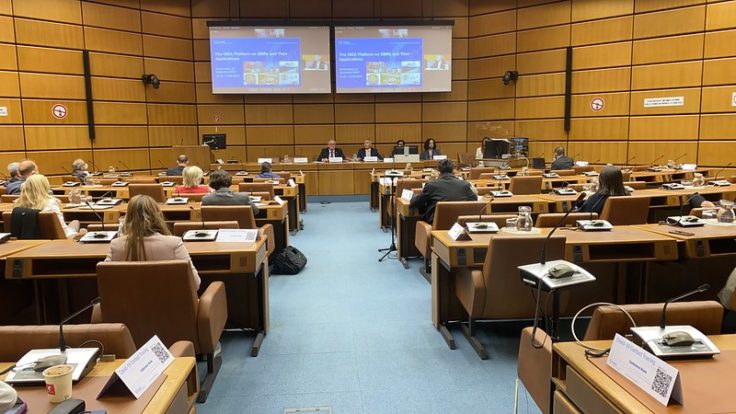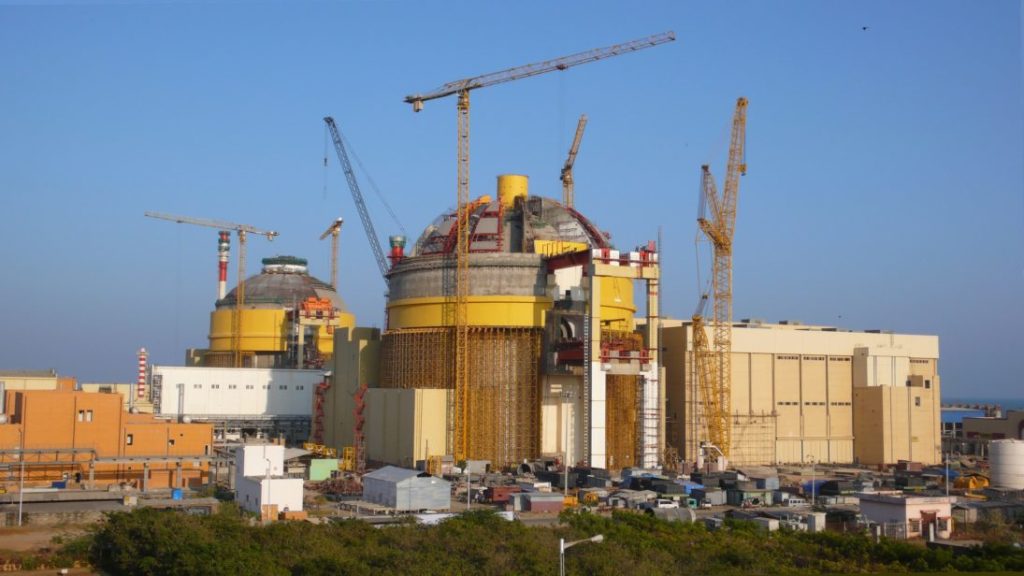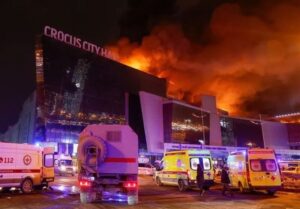Nuclear energy has consistently been a reliable source of power with the benefits of zero carbon emissions and high energy density. Despite this, nuclear energy has never been able to gather adequate backing in the energy sector, which is mostly dictated by fossil fuel industries. The pushback against nuclear energy industries can also be linked to three major nuclear accidents: Chernobyl, Three Mile Island, and Fukushima. Traditionally nuclear energy is generated by massive nuclear reactors of power of 1,000 megawatts electric (MWe) or higher per unit. In large nuclear stations, many of these units are brought together to generate power. However, these large reactors have faced criticism for their significant capital investment, depreciation costs, and lack of robust inherent passive safety features.
Small Modular Reactors (SMRs) have the potential to address several of the issues mentioned above. The International Atomic Energy Agency (IAEA) defines SMRs as reactors producing 300 MWe or below. The size of SMRs facilitates modularized construction in factories and direct assembling on operating sites, and additionally helps in the convenient transportation of reactors to the site. The initial capital and construction time involved in the production of SMRs is much less than a conventional nuclear reactor, which makes them an emerging preference against their larger counterparts in the nuclear energy world. SMRs also come equipped with passive safety features to deal with irregular conditions, whereas the conventional reactors require operator intervention to initiate active systems. SMRs can be made to operate underground or as a floating nuclear power unit. The past two decades have seen growing enthusiasm for deploying SMRs as a carbon free source of energy and at the same time addressing safety risks of nuclear energy. SMRs could also be used for other energy exhaustive processes such as cogeneration, district heating, or desalination of sea water. SMR technology has also receivedsubstantial research and development funding, which has produced innovative and cutting edge SMR designs.
With India’s Department of Atomic Energy (DAE) tracings its start to the vision of India’s renowned Nuclear Scientist, Homi Jehangir Bhabha, India’s nuclear energy program has only continued to mature over the past seven decades. However, while India’s energy demands are set to skyrocket in the coming years, the DAE’s vision has yet to be realized, with nuclear energy contributing to only a meagre share of India’s electricity generation. This essay analyzes the feasibility of India conceiving SMR research and the challenges involved. Although integrating SMRs into the nuclear power grid is still years away, working on a concept of SMRs that suits India’s current nuclear energy regime is a crucial opportunity for India to addresses the factors that have contributed to the lag in nuclear energy growth in the country.
Small Modular Reactors in India
India currently has the world’s second largest population, 1.38 billion and counting. As per the population projection report from India’s Ministry of Health and Family Welfare, India’s population is expected to grow from to 1.52 billion by 2036, an increase in 25.7 percent since 2011. Energy demands will only increase in the coming years—India has been projected to overtake the European Union as the world’s third largest energy consumer by 2030. India has a dynamic energy sector mostly dominated by fossil fuel energy plants. The fossil fuel plants have an installed generation capacity of 234,024 MW amounting to 60.2 percent of India’s total installed power generation capacity, hydro accounts for 12 percent, whereas other renewable energy account for 26.1 percent. Nuclear energy shares a meager 1.7 percent of India’s total installed power generation capacity. The reasons for backlash include nuclear’s high capital investment, long construction times, land acquisition, and safety and public concerns owing to risks of catastrophic accidents. Post-Fukushima, India’s nuclear regulatory body, the Atomic Energy Regulatory Board, carried out safety assessments of the nuclear reactors in operation and many new initiatives were introduced in the regulatory process to reduce risk of core damage. However, the concerns on expenditures, land acquisition, and long construction times persist and are yet to be fully addressed.
Although integrating SMRs into the nuclear power grid is still years away, working on a concept of SMRs that suits India’s current nuclear energy regime is a crucial opportunity for India to addresses the factors that have contributed to the lag in nuclear energy growth in the country.
Currently, the Indian nuclear power program uses a closed fuel cycle—meaning that it reprocesses spent fuel to separate fissile material (fuel) from waste products—in a three stage process. Stage one uses a natural uranium fueled Pressurized Heavy Water Reactors (PHWR), which produces energy and fissile plutonium. The second stage would then use Fast Breeder Reactors (FBRs) that are fueled with enriched plutonium and depleted uranium extracted from the spent fuel in stage one, finally the third stage reactors would use thorium, which is found in vast quantities in the country.
The second stage of India’s fuel cycle has been significantly delayed as BHAVINI—a 500 MWe Prototype FBR—has yet to be completed, causing a lag in the three-stage power program. To increase the share of nuclear energy in the country India has also started a parallel acquisition of reactors from foreign countries and plans on increasing the numbers of Indian Pressurized Heavy Water Reactors (IPHWR), a technology that India has mastered. There are currently 22 reactors operating, generating about 6780 MWe, with around 6700 MWe under construction. India has pitched further construction of 10 Indian PHWR of total of 7000 MWe and for the acquisition of two VVER (Vodo-Vodyanoi energetichesky reactor; Russian LWR) reactors from Russia of 2000 MWe by 2031 taking the total energy generated by nuclear to 22,480 MWe—three times the current value. This is an ambitious goal facing the same challenges mentioned above for large conventional NPPs. Now is the time India must look beyond traditional nuclear reactors towards the possibility of designing and building SMRs.
SMR Potential
The next steps for SMR production in India can follow the advancements which India has already made in several new nuclear technology projects. India has pitched building an Advanced Heavy Water Reactor (AHWR)-300 MWe-LEU (low enriched Uranium) small reactor and ambitiously plans on building its ownIPWR (Indian Pressurized Water Reactor) that would have a capacity around 1000 MWe (too large in MWe to be considered an SMR). The AHWR will demonstrate inherent safety characteristic with several advanced passive safety systems with first or its kind systems. There are no reports on the development status of the IPWR apart from mention of India’s intents to produce it. The AHWR core is designed to operate with a mixture of fuel derived from second stage reactors, however, as noted above these reactors are often delayed. Consequently, AHWR’s construction and operation will be delayed as well.
However, India has shown a huge success in building small Pressurized Water Reactors (PWR) of around 82.5 MW for propelling submarines. Under the Advanced Technology Vessel project, six nuclear powered submarines are planned for construction to bolster India’s nuclear triad. The DAE can extrapolate the technology of PWR type reactors already in use with Indian Navy, while combining the design and safety elements from AHWR and IPWR to design Indian SMRs. The SMR design could also be entirely a derivative of propulsion reactor like the Russian KLT-40s, the world’s only operating SMR-FNPP (Floating Nuclear Power Plant) which is a derived form of propulsion reactors used in ice-breaker ships. It will be a huge feat on account of DAE if an indigenous SMR design can see light of day, as the current political leadership endorses indigenous technology development through Atmanirbhar Bharat (self-reliant India).
Nuclear energy in India has historically been government owned and regulated. However, for SMRs to get off the ground, the DAE must consider a joint effort between government, public, and private players. Once the DAE has the design ready, it could go on to fabricate a prototype SMR in collaboration with industrial giants such as L&T, BHEL, Walchand Nagar, or others. The same concept was used to fabricate the land-based propulsion reactor prototype. The DAE will have to build new or modify existing test facilities to test and demonstrate various design and safety features of SMRs.
Challenges
Incorporating SMRs into India’s nuclear energy production is a long-term project, licensing and development time is currently the main consideration for SMRs. Constructing the first prototype and commissioning it may take more than a decade including the time for licensing activities. In India, the Atomic Energy Regulatory Board (AERB) carries out licensing activities related to construction, commissioning, and operation of NPPs. However, the AERB, which currently only overlooks the civilian application of nuclear energy, may not have the experience and knowledge of certifying reactors under strategic use. The DAE will have to frame a collaboration between various organizations involved in research of propulsion reactors, IPWRS, AHWRs, and the AERB to frame a licensing process suitable for SMRs without compromising India’s strategic interests. Deriving license and regulation protocols will require substantial research into the design safety parameters catering to SMRs.

Given the number of advantages to SMR technology, this topic has been taken up for discussion globally by various international working groups to discuss the way forward, such as the Cooperation in Reactor Design Evaluation and Licensing. India is also a part of these discussion on SMRs. The topic of licensing and regulation, staffing requirements, and basic safety specifications is something that can be developed with global collaboration as several countries—specifically the United States and Russia—are more advanced phases of licensing. Despite this, licensing difficulties present one of the most difficult challenges on the path of building first SMR prototype. Ideally, licensing activities should not exceed the construction time as this will further burden the capital investment as the reactor will not be operational even after it is constructed. Once the first prototype successfully demonstrates the SMR technology along with compliance with regulatory protocols it can be transferred to Nuclear Power Construction of India Limited (NPCIL) or any other public sector undertaking for construction and operation in fleet mode. The integration of SMRs in India’s existing nuclear power program can be done in both grid and off-grid approach. Multiple SMRs can be grouped together at power plants already housing conventional reactors, and they can be connected to an existing power distribution infrastructure (grid). SMRs can also be made in a distributive manner where grid connections can be closer to promote grid stability and avoid transmission losses. However, due to public concerns over new nuclear sites, the ideal approach for India would be to have multiple SMRs at sites close to already existing NPPs. The off-grid approach maybe suitable for places which lack a grid distribution system for example, the Andaman Islands where power distribution is through stand-alone systems via diesel generators.
Due to public concerns over new nuclear sites, the ideal approach for India would be to have multiple SMRs at sites close to already existing nuclear power plants.
SMR development will need a nuclear fuel cycle as well, which can be either a derivative of existing fuel cycles or system dedicated fuel cycle. The fuel cycle for SMRs will have to be developed in an approach that is compatible with India’s current fuel cycle—especially the back end of the cycle, which involves reprocessing of spent fuel. However, the reprocessing of SMR spent fuel may only be an option with India if the fuel is indigenous, as fuel imported from abroad will need to be placed in a spent fuel storage facility on an interim basis. No matter how good the strategy is for managing spent fuel, the final disposal of nuclear waste is an ongoing challenge for nuclear energy—whether produced with SMRs or conventional NPPs. The effective management of nuclear waste remains a crucial problem for the nuclear industry and a major concern of the public as well.
One of the key challenges is also the economics factor which also needs to be evaluated carefully. The cost of SMRs can be divided between construction, operation, fuel cycle, and decommissioning. Delays in licensing procedures will have a significant impact on the economic advantages that SMRs have over large reactors. This is something that will have to be considered critical to success of small reactors.
Beyond licensing and economic challenges, the main obstacle that not only SMRs but the whole of nuclear energy industry faces in India is public perception. There is a general lack of trust and concerns from local communities over the addition of NPPs. The anti-nuclear protests outside nuclear power plants in Kudankulam, Tamil Nadu, and Jaitapur, Maharashtra are two significant resistance movementsin the last two decades. The major reason of local public distrust is social in nature. To construct an NPP a huge area of land is acquired including the exclusion zone which leads to large displacement of the public from the area. Even well compensated local communities may eventually develop grudges because of various restrictions owing to natural growth zone (five kilometers) around the NPP which mandates only natural growth activities can take place in the region. These public issues combined with events such as the Fukushima accidents cause concerns about nuclear energy. Although Indian nuclear plants have been able to maintain a generally strong safety record—with experiences gained from few incidents putting their safety features to test—there is always a scope of improvement. The AERB, which is the main responsible authority, has yet to become formally independent. A strong independent nuclear regulatory body can create stronger trust among the public, and allow their voices to be an influence in various regulatory phases of NPPs. The AERB is functionally independent from DAE but an act or law passed by the Indian parliament would strengthen its independence. A bill in this regard “NSRA (Nuclear Safety Regulatory Authority)” was proposed in the parliament but is still yet to see enforcement. This is something that the Indian law makers must look at before trying to concept other established NPP technologies let alone SMRs.
The current nuclear energy regime of India faces a number of issues which can be directly or indirectly addressed through SMRs.
It will take significant dedication to awareness campaigns to build support from the Indian public and trust that SMRs are efficient and safe. This will be a major challenge since the term “nuclear” itself reflects a history of destruction. However, with efficient public outreach the image of nuclear energy can be improved to pave the path for SMRs or future nuclear energy projects. SMRs also require a smaller area for construction and low core inventory, which allows for smaller exclusion zone and emergency planning zone with reduced risks of offsite emergency, and may reduce the land acquisition concerns that come with large NPPs. Deploying SMRs in lieu of large reactors will avoid displacement of large populations owing to land acquisition issues. This advantage will have to be coupled with initiatives that focus on preferences of local host communities and addressing their safety concerns to enable smooth deployment and acceptance of SMRs. Embedding opportunities for local and regional job creation, will also further help nuclear energy’s overall acceptance.
Conclusion
SMRs are in race to become a part of the global energy regime as a competitive low carbon technology component. India, which aims to have economic dominance in South Asia, cannot afford to be behind in this race, however, it has yet to arrive at the starting line. The current nuclear energy regime of India faces a number of issues which can be directly or indirectly addressed through SMRs. One can simply envisage the difference that deploying SMRs will create in remote regions of India such as Andaman Islands and Northeast regions. SMRs potential deployment around Special Economic Zones surrounding energy exhaustive industries will only boost India’s economic growth. It is need of the hour that Indian government vests its time and finances into the SMR program to better address the energy needs of the subcontinent. The road to realizing SMRs will be difficult but not impossible as India’s DAE is capable of making it a reality.
This article was originally published in South Asian Voices.




